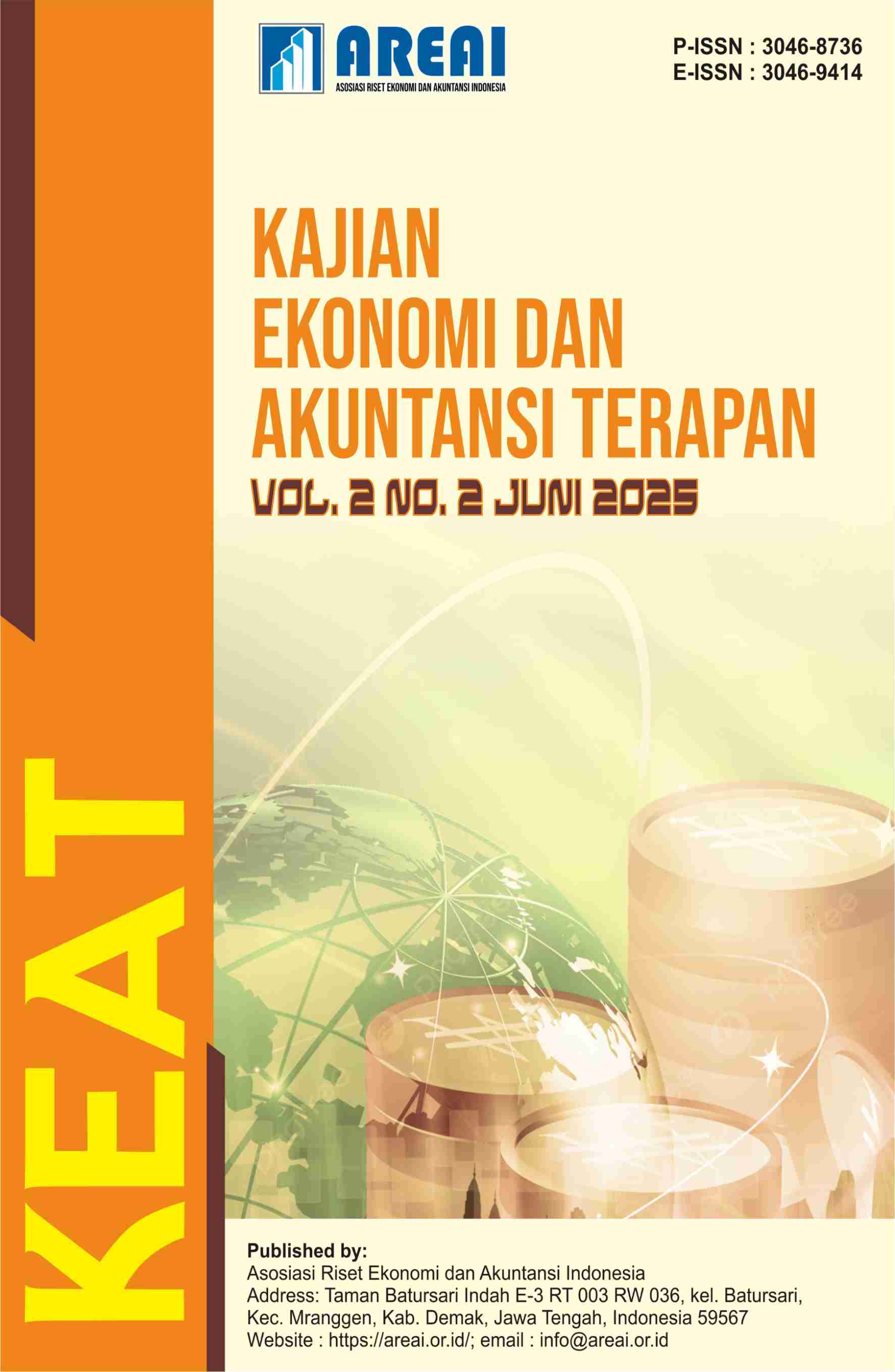Pengaruh Literasi Keuangan, Penggunaan Digital Payment, dan Pendapatan terhadap Inklusi Keuangan di DKI Jakarta
DOI:
https://doi.org/10.61132/keat.v2i2.1163Keywords:
Financial Inclusion, Financial Literacy, Digital Payments, IncomeAbstract
This research aims to analyze the influence of financial literacy, digital payment usage, and income on financial inclusion in DKI Jakarta. This study uses a quantitative approach with a survey method through questionnaires distributed to 157 respondents who are digital payment users aged 15-59 years, have an income, and reside in DKI Jakarta. The analysis results show that financial literacy, digital payment usage, and income each have a positive and significant impact on financial inclusion. The R² value of 0.588 indicates that 58.8% of the variation in financial inclusion can be explained by the variables of financial literacy, digital payment usage, and income. Meanwhile, the remaining 41.2% is explained by other factors not discussed in this study.
Downloads
References
Adetunji, Michael, O., David-West, & Olayinka. (2019). The Relative Impact of Income and Financial Literacy on Financial Inclusion in Nigeria. Journal of International Development, 31(4), 312–335. https://doi.org/10.1002/jid.3407
Alkhowaiter, W. A. (2020). Digital payment and banking adoption research in Gulf countries: A systematic literature review. International Journal of Information Management, 53(September 2019), 102102. https://doi.org/10.1016/j.ijinfomgt.2020.102102
Aprilia, S. R. (2022). Pengaruh Literasi Keuangan Dan Cashless Payment Usage Terhadap Inklusi Keuangan Di Dki Jakarta (Studi Pada Pengguna E-Wallet). Thesis, 1–14.
Badan Pusat Statistik. (2022). Proporsi Remaja dan Dewasa Usia 15-59 Tahun dengan Keterampilan Teknologi Informasi dan Komputerisasi (TIK) (Vol. 1, Issue 1). https://www.bps.go.id/id/statistics-table/2/MTQ0NyMy/proporsi-remaja-dan-dewasa-usia-15-59-tahun-dengan-keterampilan-teknologi-informasi-dan-komputer-tik-menurut-provinsi.html
Barajas, A., Beck, T., Belhaj, M., & Naceur, S. Ben. (2020). Financial Inclusion: What Have We Learned So Far? What Do We Have to Learn? IMF Working Paper, 20(157). https://www.imf.org/-/media/Files/Publications/WP/2020/English/wpiea2020157-print-pdf.ashx
Demirguc-Kunt, A., Klapper, L., Singer, D., Ansar, S., & Hess, J. R. (2018). The Global Findex Database 2017 : Measuring Financial Inclusion and the Fintech Revolution. World Bank Group. http://documents.worldbank.org/curated/en/332881525873182837/The-Global-Findex-Database-2017-Measuring-Financial-Inclusion-and-the-Fintech-Revolution
Dyah Praptitorini, M., Shobandiyah, S., & Tinggi Ilmu Ekonomi Totalwin, S. (2022). Pengaruh Literasi Keuangan Dan Layanan Keuangan Berbasis Teknologi Terhadap Inklusi Keuangan (Studi Kasus pada UMKM di Kabupaten Demak). The Academy Of Management and Business (TAMB), 01(2), 69–79. https://edumediasolution.com/index.php/tamb
Hudayani, A. R., Ulupui2, I. G. K. A., & Buchdadi, A. D. (2022). The Influence of Gender , Lifestyle , and Income on Financial Literacy in Young Employees through Saving Behavior as A Moderating Variable. The International Journal of Social Sciences World, 4(2), 420–430. https://doi.org/: https://doi.org/10.5281/zenodo.7627402
Jange, B., Pendi, I., & Susilowati, E. M. (2024). Peran Teknologi Finansial (Fintech) dalam Transformasi Layanan Keuangan di Indonesia. Indonesian Research Journal on Education, 4(3), 1199–1205. https://doi.org/10.31004/irje.v4i3.1007
Khan, F., Siddiqui, M. A., & Imtiaz, S. (2022). Role of financial literacy in achieving financial inclusion: A review, synthesis and research agenda. In Cogent Business and Management (Vol. 9, Issue 1). Cogent OA. https://doi.org/10.1080/23311975.2022.2034236
Kim, H. Y. (1999). Economic Capacity Utilization and its Determinants: Theory and Evidence. Review of Industrial Organization, 15, 321–339. https://doi.org/https://doi.org/10.1023/A:1007747813591
Klapper, L., & Singer, D. (2014). The Opportunities of Digitizing Payment. World Bank Group. http://documents.worldbank.org/curated/en/188451468336589650/The-opportunities-of-digitizing-payments
Kumar Vaid, Y., Singh, V., & Sethi, M. (2020). Determinants of Successful Financial Inclusion in Low-Income Rural Population. The Indian Economic Journal, 68(1), 82–100. https://doi.org/10.1177/0019466220962057
Mursita, N. E. (2024). Pengaruh Literasi Keuangan dan Penggunaan Digital Payment terhadap Perilaku Konsumtif pada Generasi Z di Jakarta [Universitas Negeri Jakarta]. http://repository.unj.ac.id/id/eprint/47194
Nuryyev, G., Spyridou, A., Yeh, S., & Lo, C. C. (2021). Factors of digital payment adoption in hospitality businesses: A conceptual approach. European Journal of Tourism Research, 29(July). https://doi.org/10.54055/ejtr.v29i.2416
OECD. (2016). OECD/INFE International Survey of Adult Financial Literacy Competencies. OECD/INFE International Survey of Adult Financial Literacy Competencies. https://doi.org/10.1787/28b3a9c1-en
OECD. (2024). Income Inequality. https://doi.org/https://doi.org/10.1787/459aa7f1-en
OJK, & BPS. (2022). Survei Nasional Literasi Dan Inklusi Keuangan Tahun (SNLIK) 2022. In Otoritas Jasa Keuangan. https://ojk.go.id/id/berita-dan-kegiatan/siaran-pers/Pages/Survei-Nasional-Literasi-dan-Inklusi-Keuangan-Tahun-2022.aspx
OJK, & BPS. (2024). Survei Nasional Literasi dan Inklusi Keuangan (SNLIK) 2024. https://ojk.go.id/id/berita-dan-kegiatan/siaran-pers/Documents/Pages/OJK-dan-BPS-Umumkan-Hasil-Survei-Nasional-Literasi-dan-Inklusi-Keuangan-Tahun-2024/SP OJK dan BPS Umumkan Hasil Survei Nasional Literasi dan Inklusi Keuangan Tahun 2024.pdf
Patel, A. S., Rao, V. K., & Radhakrishnan, M. K. (2023). Impact of Mobile Banking Platforms Paytm and Google Pay on Financial Inclusion in Rural and Semi-Urban Areas in India. Journal of Finance and Accounting, 7(5), 113–122. https://doi.org/10.53819/81018102t4205
Poddala, P., & Alimuddin, M. (2023). Meningkatkan Literasi Keuangan Pada Generasi Milenial. Journal of Career Development, 1(2), 17–25. https://doi.org/https://doi.org/10.37531/jcd.v1i2.38
Prameswari, S., Nugroho, M., & Pristiana, U. (2023). Pengaruh Literasi Keuangan, Kesadaran Keuangan, Pendapatan Terhadap Kesejahteraan Keuangan dengan Perilaku Keuangan dan Inklusi Keuangan. CAKRAWALA – Repositori IMWI, 6(1), 505–516.
Reshinta, A. H. (2021). PENGARUH PENGALAMAN DAN PENGETAHUAN KEUANGAN PADA GENERASAI MILENIAL TERHADAP PERILAKU PERENCANAAN INVESTASI DENGAN MODERASI PENDAPATAN. Thesis (Undergraduate). http://eprints.perbanas.ac.id/id/eprint/7814
Setyawan, E. (2023). Analisis Pengaruh Inklusi Keuangan Terhadap Pertumbuhan Ekonomi Indonesia. Kementerian Koordinator Bidang Perekonomian, 1–26. http://snki.go.id/wp-content/uploads/2025/03/Analisis-Pengaruh-Inklusi-Keuangan-Terhadap-Pemerataan-Ekonomi-.pdf
SNKI. (2020). Laporan Strategi Nasional Keuangan Inklusif (SNKI). https://snki.go.id/wp-content/uploads/2023/02/Laporan-SNKI-2020-v8.pdf
Somantri, L. (2024). Pemetaan mobilitas penduduk di kawasan pinggiran Kota Bandung. Majalah Geografi Indonesia, 36(2), 95. https://doi.org/10.22146/mgi.70636
Strömbäck, C., Lind, T., Skagerlund, K., Västfjäll, D., & Tinghög, G. (2017). Does self-control predict financial behavior and financial well-being? Journal of Behavioral and Experimental Finance, 14, 30–38. https://doi.org/10.1016/j.jbef.2017.04.002
Suwatno, S., Waspada, I. P., & Mulyani, H. (2020). Meningkatkan Perilaku Pengelolaan Keuangan Mahasiswa Melalui Financial Literacy dan Financial Sel Efficacy. Jurnal Pendidikan Akuntansi & Keuangan, 8(1), 87–96. https://doi.org/10.17509/jpak.v8i1.21938
Widayati, T., P, M. A. C., GS, A. D., Nugroho, N., Rahayu, S., Boari, Y., Syamil, A., & Suryahani, S. P. A. I. (2023). PEREKONOMIAN INDONESIA: Perkembangan & Transformasi Perekonomian Indonesia Abad 21 Terkini. (1st ed.). PT. Sonpedia Publishing Indonesia. https://books.google.co.id/books?hl=id&lr=&id=4QbHEAAAQBAJ&oi=fnd&pg=PA80&dq=Inovasi+yang+terus+berkembang+dalam+teknologi+keuangan+yang+secara+progresif+semakin+mencakup+berbagai+lapisan+masyarakat,+telah+mendorong+perkembangan+inklusi+keuangan+di+Indone
World Bank. (2020). National Financial Inclusion Strategy. In Government of Ghana. World Bank Group. https://www.bou.or.ug/bou/bou-downloads/publications/special_pubs/2017/National-Financial-Inclusion-Strategy.pdf
World Bank. (2021). Global Financial Inclusion. https://databank.worldbank.org/source/global-financial-inclusion#
Yanti, W. I. P. (2019). Pengaruh Inklusi Keuangan Dan Literasi Keuangan Terhadap Kinerja Umkm Di Kecamatan Moyo Utara. Jurnal Manajemen Dan Bisnis. Jurnal Manajemen Dan Bisnis, 2(1), 1–10.
Downloads
Published
How to Cite
Issue
Section
License
Copyright (c) 2025 Kajian Ekonomi dan Akuntansi Terapan

This work is licensed under a Creative Commons Attribution-ShareAlike 4.0 International License.





